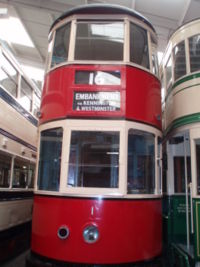London County Council Tramways No. 106
 |
It may contain current routes and equipment or historic routes and equipment no longer in service. Reason: Historic London County Council Tramways No. 106 Please feel free to discuss this article on the talk page. |
| This page is under construction. This article is currently undergoing expansion or major revamping. However, you are welcome to assist in its construction by editing it as well. While actively editing, consider adding {{inuse}} to reduce edit conflicts. |
| |
This article is uncategorized. Please categorize this article to list it with similar articles. |
| LCC 106 | |
|---|---|

| |
| unrelated image used for testing purposes only. | |
| Manufacturer | Electric Railway and Tramway Carriage Works |
| Total production | 80 |
| Dates in service | 1903 |
| Class | B |
| Number of decks | 2 |
| Type of trucks | Brill (USA) type 21E |
| Motor(s) | (UK) type DK25A, 25hp (19kW) |
| Wheelbase | 6 ft 6 ins (1.98metres) |
| Length | 28 ft 9 ins (8.76metres) |
| Width | 7 ft 1 ins (2.16metres) |
| Height | 16 ft 4 ins (4.98metres) |
| Current Collector | underground conduit system |
| Withdrawn from Service | 1926 |
| Date restored | 1983 |
| {{Infobox UK Tramway}} | |
LCC 106 was the first tram restored by the LCCTT.
106 was built in 1903, as one of a 100 ‘B’ class tramcars. In 1926, after being withdrawn from passenger service, it was converted into a snowbroom (No 022). In this form it last saw active service during the winter of 1951-52.
After escaping the one way trip to the scrapyard and many years in storage the LCCTT commenced restoration work in 1970, at their Bonwell Street workshop in East London. There followed 13 years of hard dedicated work by Trust members.
In 1983 106 was transferred to the Crich Tramway Village in Derbyshire where it has covered in excess of 10,000 miles in passenger service.
Other pictures of 106 can be viewed on the gallery page
LCC 106 – TECHNICAL DESCRIPTION AND SHORT HISTORY
Built:
April 1903 by Electric Railway and Tramway Carriage Works, Preston, for Dick, Kerr and Company. One of 80 Class B cars ordered by London County Council.
Withdrawn:
1925 from passenger service. Converted to snow broom in 1927 by removing top deck, fitting brushes under platforms, and increased power motors. Car renumbered 022. Out of service April 1952 as snow broom.
Body Condition:
Originally open top with reversed stairs. Seats 22 downstairs and 34 upstairs. Timber construction with steel strengthening.
Rebuilt by 1911 with fully enclosed top deck probably retaining reversed stairs.
Direct stairs fitted by 1914.
Restored to represent one of 8 Class B/4 cars with open top and trolley mast.
Main Dimensions:
Length: - 28 ft 9 ins (8.76metres)
Width: - 7 ft 1 ins (2.16metres)
Height with open top deck: - 13 ft 0 ins (3 96metres)
Height with covered top deck: - 16 ft 4 ins (4.98metres).
Truck:
Brill (USA) type 21E, 6 ft 6 ins (1.98metres) wheel base.
Wheel Diameter: - 2 ft 7 ins (0.80metres)
Motors (2):
Originally Dick, Kerr (UK) type DK25A, 25hp (19kW)
Replaced in 1927 by Westinghouse (UK) type 220, 42hp (31kW) taken from Class E/1 car.
Controllers (2):
Originally Dick, Kerr (UK) type DB-1-D
Replaced in 1927 by Westinghouse (UK) type T2C taken from Class E/1 car.
Power Collection:
Originally underground conduit system with plough carrier mounted in centre of truck wheel base.
Trolley pole fitted in 1927 when rebuilt as snow broom.
Trolley mast fitted in 1983 when restored for use at Crich Museum.
Braking System:
Originally hand brake on wheels, and dynamic (rheostatic) through motors.
Magnetic track brakes fitted by 1908.
Preservation:
Car retained by London Transport after withdrawal in 1952 to be restored to original condition. Project not begun by LT; car donated to LCC Tramways Trust for eventual restoration for National Tramway Museum, Crich. Work begun in 1971 and completed 1983. Car presented to National Tramway Museum on 15th May 1983 (80th anniversary of opening of LCC electric tramways).

